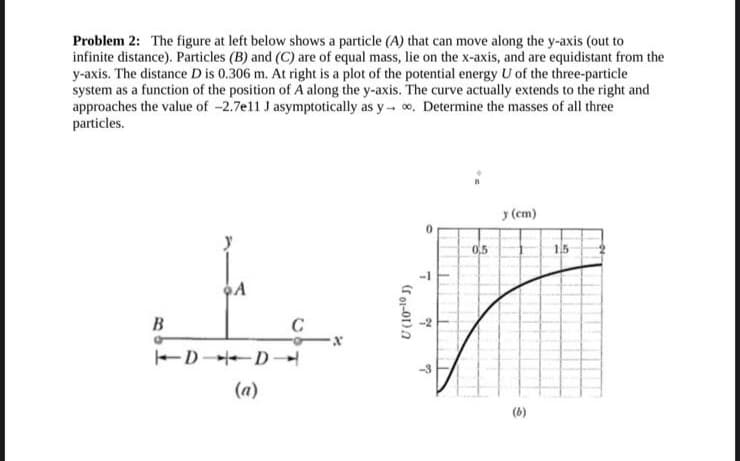Problem 2: The figure at left below shows a particle (A) that can move along the y-axis (out to infinite distance). Particles (B) and (C) are of equal mass, lie on the x-axis, and are equidistant from the y-axis. The distance D is 0.306 m. At right is a plot of the potential energy U of the three-particle system as a function of the position of A along the y-axis. The curve actually extends to the right and approaches the value of -2.7e11 J asymptotically as y→ ∞. Determine the masses of all three particles. A 다. C HDD- B T (f 01-01) Of -3 0,5 y (cm) € 15
Problem 2: The figure at left below shows a particle (A) that can move along the y-axis (out to infinite distance). Particles (B) and (C) are of equal mass, lie on the x-axis, and are equidistant from the y-axis. The distance D is 0.306 m. At right is a plot of the potential energy U of the three-particle system as a function of the position of A along the y-axis. The curve actually extends to the right and approaches the value of -2.7e11 J asymptotically as y→ ∞. Determine the masses of all three particles. A 다. C HDD- B T (f 01-01) Of -3 0,5 y (cm) € 15
Related questions
Question
Needed to be solved this question correctly in 30 minutes and get the thumbs up please show neat and clean work for it
By hand solution needed
Please do ? percent correct

Transcribed Image Text:Problem 2: The figure at left below shows a particle (A) that can move along the y-axis (out to
infinite distance). Particles (B) and (C) are of equal mass, lie on the x-axis, and are equidistant from the
y-axis. The distance D is 0.306 m. At right is a plot of the potential energy U of the three-particle
system as a function of the position of A along the y-axis. The curve actually extends to the right and
approaches the value of -2.7e11 J asymptotically as y∞. Determine the masses of all three
particles.
B
o
A
DD
(a)
C
(f 01-01)
L
to
do
0,5
y (cm)
(6)
15
Expert Solution
This question has been solved!
Explore an expertly crafted, step-by-step solution for a thorough understanding of key concepts.
Step by step
Solved in 2 steps with 2 images
